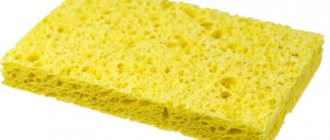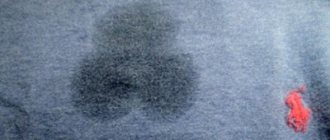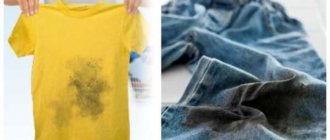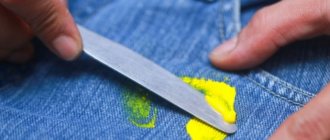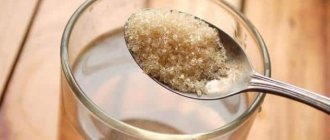In this article we will look at how to wash acrylic paint at home from different surfaces.
No matter how carefully the repair is carried out, stains can get or seep onto your furniture, floors or even things. Now acrylic paint has become very popular, which is much better than the old analogue, but sometimes it leaves stains. Of course, it’s much easier to remove fresh paint, but with old dried stains you need to tinker a little. And we will talk about such minor secrets and tricks in this material.
How to remove fresh stains
If the paint coat is recently applied, there is no need to use chemicals. Simply moisten the sponge in warm water and rinse the surface. To clean your brushes after use, leave them in water for 15 minutes and then hold them under pressure. When the contamination is fresh, but has landed on a surface that is quickly eaten into, additional products will need to be applied.
See also
How to clean a mouse pad at home, 5 best products
Sunflower oil and laundry soap
It is very difficult to remove even fresh paint stains from clothes, and the result directly depends on the type of fabric. Immediately after the substance gets on clothing, it is necessary to treat the area with sunflower oil and soak for 15 minutes in hot water, after rubbing with laundry soap. After soaking, you should wash the clothes in a washing machine or by hand.
White Spirit
Paint stains can be removed from most fabric surfaces using white spirit. To wipe off paint with a solvent, you need to apply a small amount to a rag or sponge and gently rub it over the dirt.
Isopropyl alcohol
Isopropyl alcohol is an organic solvent. To remove dirt from the surface, you need to apply alcohol and wash it off after a few minutes. If the paint begins to eat in, you should use a hard sponge.
Nail polish remover
You can remove acrylic paint from clothing or fabric surfaces using nail polish remover that does not contain acetone. This is important to preserve the structure and color of the material. Nail polish remover effectively removes only fresh stains.
Ammonia and vinegar
In cases where it is not possible to remove the paint using other methods, you can use vinegar and ammonia. It is enough to soak a cotton pad or soft cloth in the solutions, and then treat the stain until it completely disappears.
Window cleaner and brush
The composition of various window cleaning products contains components that dissolve acrylic.
To erase stains using these products, you need to apply a small amount to the dirt and clean off the acrylic composition with a hard-bristled brush.
Hair fixation spray
Applying hairspray to fresh acrylic paint affects its texture and makes it easy to wash off. The composition peels off from exposure to the varnish, and it is enough to treat the surface with a rag or sponge.
Methods for identifying various types of household decorative and finishing plastic
Available methods for determining the type of plastic mass are as follows:
- Decoding the plastic markings on the back side of the product plate. Mainly used for imported window trim panels and plastic interior doors.
- Method of igniting the material: the nature of combustion also helps to determine the type of plastic.
- According to the density of the material, for which the part is immersed in water.
Let's consider these methods in more detail.
Marking
According to the international classification of plastic materials that are used in everyday life for the manufacture of window panels, door slopes, etc., all plastics have a certain digital designation. It is indicated in a triangle embossed on the back of the part. The international identification codes for the plastics used are as follows:
Plastic identification codes
- polyethylene terephthalate - PET, number in triangle 1,
- polyethylene, respectively low and high density - LDPE and HDPE, numbers in the triangle 4 or 2,
- polyvinyl chloride - PVC, number in triangle 3,
- polypropylene - PP, the number in the triangle is 5,
- polystyrene – PS, number in triangle 6.
Recipes for removing old stains at home
Dried acrylic paint is much more difficult to remove than fresh stains. In domestic conditions, various substances can be used for this purpose, which differ in composition, method of application and effect on pollution.
See also
The best ways to properly clean a vacuum cleaner and whether it can be washed
Vinegar
To remove stains, vinegar is mixed with ammonia and salt. The surface from which the acrylic composition needs to be wiped off is first washed with cold water, then a sponge or lint-free cloth is soaked in the prepared solution and the stains are wiped. As the sponge dries, it is re-wetted in the solution. The procedure is performed until the desired result. After finishing the work, you should wash off the remaining solution with water.
Soda
Using baking soda is suitable for removing small paint stains. The contaminated area must be completely covered with a layer of soda and begin to rub with a moistened sponge. Remove any remaining product with a clean cloth.
Detergent
To remove stains with detergent, you must first blot the surface with warm water. Then rub the stain with the product using a sponge and leave for 3-4 hours.
After this time, the detergent is washed off along with the remaining acrylic paint.
Acetone
The constituent components of acetone allow you to effectively scrape dried acrylic composition from the surface. If the paint has dried for a long time and you need to wash it off, you will need to soak a cotton pad in acetone, apply it to the area and wipe with force. It is necessary to treat the stain until the desired effect is achieved. For processing, you can use pure acetone or nail polish remover containing this substance.
Refined gasoline
When using gasoline to remove stains, you need to soak a cotton pad or rag in pre-cleaned gasoline and then wipe the stained area. If you need to remove stains from clothes, then after treating with gasoline, you need to rinse the item in clean water and wash it in a machine for final cleaning.
Kerosene
Since kerosene is an aggressive substance, when using it it is necessary to use protective gloves and a respirator. To clean the surface, you need to apply kerosene and wipe with a sponge. The film former of the acrylic composition softens within half an hour, and during this time it is necessary to perform the wetting procedure several times. After the paint peels off, you can replace the sponge with a soft cloth with a more durable base.
See also
Which gloves are best to choose for washing dishes and what to consider?
Turpentine
Turpentine is often used to dilute varnishes, so using it in larger quantities allows you to effectively wash off the composition from different surfaces. The cleaning procedure is standard and involves applying turpentine to a cloth or cotton pad and further treating the surface.
Denatured alcohol
You can remove a layer of paint with denatured alcohol using the basic method. The contaminated surface is treated with the product and wiped with a brush.
How to remove acrylic paint from carpet or carpet?
Of course, before painting, you should remove all carpeting to avoid staining it. But there are different situations. It may happen that a new expensive carpet or even carpet will be damaged by acrylic paint. Don't be upset; you need to take immediate action to preserve the beauty of your carpet.
- Fresh paint only needs to be blotted with a paper towel. Do not rub the product into the carpet under any circumstances Otherwise, the paint will only penetrate deeper.
- Then use the same paper towel or cotton ball soaked in glycerin to blot off any remaining paint. This must be done until all the pigment is gone.
- Soak the painted area with rubbing alcohol. Make sure it is completely absorbed and leave on for 5 minutes. This will give time for the paint's weakening effect to begin. Start wiping the area with a paper towel. Do not rub the dye onto clean areas of the carpet when you wipe the stain, but try to keep it in one place, working towards the center. Continue scrubbing until the paint is gone. It may take two or three soaks before all the paint is removed.
Do not rub the stain across the carpet, but try to move towards the center
Features of removal from various surfaces
The nuances of washing off acrylic depend on the type of surface. It is important to consider several features to achieve the desired effect.
Linoleum
Linoleum is resistant to damage, so the paint can be scraped off with a knife. For peeling, you can use acetone or any solvent.
Tile
The process of washing acrylic from tiles is carried out in a similar way to cleaning linoleum. You can use any chemical.
Glass
For glass processing, it is better to use white spirit. To scrape off any remaining paint, use a sharp blade.
Plastic
To avoid damaging the plastic, it is better to use organic solvents for flushing. Wipe the surface with a soft cloth.
Brick
You can remove paint from brick using gasoline or kerosene. The products will not damage the brick and will effectively wash away the acrylic composition.
Concrete
Concrete can be treated with any type of solvent. The variability of choice is related to the structure of the concrete.
Wallpaper
It is better to remove paint from wallpaper using natural solvents. The use of chemicals may cause the wallpaper to change color.
Textile
Acrylic compounds are strongly absorbed into the fabric. To remove stains, you need not only to treat with a solvent, but also to wash.
Preparatory operations
In addition to the type of plastic, you should also find out the type of composition with which it was once painted. For example, water-based paint is the easiest to remove. It is enough to heat the surface that has been painted with water-based paint.
For water-based paint, surface temperatures of 60-75°C will be sufficient. Such work must be carried out in the warm season, since with a high temperature contrast, the water-based paint will be removed, but the surface of the plastic product may receive residual deformation.
For other types of paints, washing them by surface heating of plastic is ineffective. Therefore, the surface of the window and door being prepared for cleaning must be thoroughly cleaned of dust and dirt, and then stocked up with:
- a respirator (in extreme cases, a gauze bandage);
- a set of cotton swabs;
- a brush to remove old paint from a window or the surface of a door leaf.
Work must be performed with rubber gloves, since all solvents are toxic and can provoke the development of skin diseases. The room in which washing work will be carried out must be effectively ventilated.
Nothing helps - what to do?
Removing old layers of paint from plastic that has a complex shaped shape using conventional means can be difficult due to its texture. Using liquid glass and silicone sealant will help solve the problem .
During the natural drying process, these preparations lead to loosening of the paintwork. And dried material can simply be cleaned off.
But if other methods do not help, you will have to use the most radical method - scraping off the dried coating.
For these purposes the following is used:
- sandpaper;
- stationery knife;
- razor blade;
- table knife, etc.
During the cleaning process, the surface is cleaned mechanically. Cured paint is quite hard and will often come off with a layer of plastic when using abrasive or sharp cleaning tools.
Radical methods of cleaning paint, although they cope with the task, but lead to serious damage. Even with great care, irreparable damage can be caused to the surface .
After such cleaning of plastic using aggressive methods, its surface will need to be polished and coated with a new layer of paint.
Composition and properties of acrylic varnish
Acrylic varnish is a transparent mixture of water-based components. It consists of:
- liquid polymers;
- antiseptic substances that protect the surface from the effects of temperature, moisture and microorganisms;
- plasticizers that create an aesthetic, even and smooth top layer.
This information is necessary to understand how to remove acrylic varnish. To completely eliminate unnecessary stains, various solvents are used. Among them, ordinary leather, as well as products based on gasoline, ethanol, and diethyl are considered the best.

